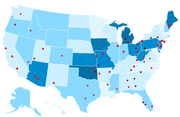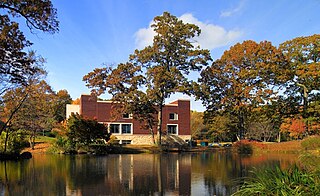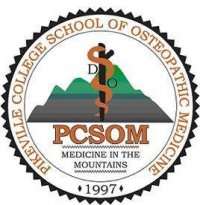| Country | Year of latest policy | Medical practice rights | Requirements for licensure |
|---|
| Argentina | 2006 | Unlimited | Foreign physicians must submit credentials to various agencies and then appear before any of the National Universities to have their diploma recognized. |
| Australia | 2013 | Unlimited | According to documents published online, the Medical Board of Australia has "agreed to accept the DO USA as a primary medical qualification for medical registration provided that the DO USA was awarded by a medical school which has been accredited by the Commission on Osteopathic College Accreditation". [58] |
| Austria | 2009 | Unlimited | Hospital must have position unable to be filled by Austrian physician. |
| Bahamas | 2004 | Unlimited | US license recognized. |
| Bahrain | 2010 | Unlimited | US license recognized. |
| Bangladesh | 2000s | Unlimited | US license recognized. |
| Barbados | 1995 | Limited | Osteopathic manipulative medicine (OMM) only. |
| Belize | 2009 | Unlimited | Must complete a Belizean residency for permanent license eligibility. |
| Bermuda | 1997 | Unlimited | Required at least 2 years of GME and examination or interview by the council's Examination Committee. Non-Bermudans must have approval from the Ministry of Labour and Home Affairs to work on the island. |
| Botswana | 2019 | Unlimited | |
| Brazil | 2007 | Unlimited | Completion of Brazilian board exam, establishing residency and some training in a Brazilian hospital is required. |
| Canada | Alberta | | Unlimited | Requires at least 2 years of GME accredited by the ACGME or AOA and must have passed the Universities Coordinating Council Exam, a basic sciences exam, and have passed all three parts of the Licentiate of the Medical Council of Canada. |
| British Columbia | | Unlimited | Requires at least 1 year of GME approved by the AOA or the ACGME, completed at least 1 year of GME in Canada, passed all three parts of the LMCC. |
| Manitoba | | Unlimited | US license recognized. |
| New Brunswick | | Unlimited | Requires at least 2 years of GME approved by the AOA or the ACGME and has passed all 3 parts of the LMCC. Reciprocity pathway for DO physicians with a Maine license. |
| Newfoundland | | Unlimited | The Medical Act 2011 allows full licensure of osteopathic physicians, both for the country's full registry and its educational registry. |
| NW Territories | | Unlimited | US license recognized. |
| Nova Scotia | | Unlimited | Requires a Canadian or ACGME residency. |
| Ontario | | Unlimited | Requires a Canadian or ACGME residency. |
| Prince Edward Island | | Unlimited | |
| Quebec | | Unlimited | Requires 1 year of GME approved by the AOA or ACGME, 1 year of GME in Quebec passed the written, oral and clinical board examination of the College of Family Physicians of Canada, and must speak French fluently. |
| Saskatchewan | | Unlimited |
| Yukon | | Unlimited | US license recognized. |
| Cayman Islands (UK) | 1983 | Unlimited | US license recognized. |
| Central African Republic | 1990 | Unlimited | US licensure and annual attendance at the National Congress for Physicians. |
| Chile | 2008 | Unlimited | A written exam in Spanish is required, besides a series of practical tests involving common procedures (CPR, intubation, lumbar puncture, etc.). |
| China | 2009 | Unlimited | United States DO physicians are permitted to apply for short-term medical practice licensure. |
| Colombia | 1996 | Unlimited | Same requirements as other foreign physicians. |
| Costa Rica | 2009 | Unlimited | Same requirements as other foreign physicians. |
| Dominican Republic | 2000 | Unlimited | US license & board certification recognized. |
| Ecuador | 1990 | Unlimited | Same requirements as other foreign physicians. Reciprocity exists in most Latin American countries. |
| Eswatini | 2019 | Unlimited | |
| Ethiopia | 2011 | Unlimited | Must renew the license every 5 years. |
| Finland | 1996 | Unlimited | Same requirements as other foreign physicians. |
| France | 2009 | Limited | OMM only. The French government does not recognize the full scope of practice of osteopathic medicine. |
| The Gambia | 2011 | Unlimited | |
| Germany | 2008 | Unlimited | Same requirements as other foreign physicians. Depends on the need. Decisions are made on an individual basis. |
| Ghana | 2019 | Unlimited | |
| Greece | 2009 | Unlimited | Greek citizenship is required, unless, in rare instances, there exists a crucial need for certain types of specialist physicians. Further, a work permit must be obtained, a difficult task, and speaking Greek is an unwritten requirement. These are the same requirements as other foreign physicians. |
| Grenada | 2007 | Unlimited | US license recognized. |
| Guyana | 1996 | Unlimited | Case-by-case basis. |
| Honduras | 2009 | Unlimited | Universidad Nacional Autónoma de Honduras must accredit all foreign titles. After accreditation is completed, the applicant must seek registration with the Medical College of Honduras (MCH). |
| Hong Kong | 1998 | Unlimited | Written examination. Personal interview. Training approval. |
| India | 2019 | Unlimited | The DO degree is recognized for full medical and surgical practice. As of 2019, a DO may practice medicine only if he/she did ACGME residencies, which are already recognized by the National Medical Commission. [59] According to the Indian Medical Act of 1956, "Provided further that a person seeking provisional or permanent registration shall not have to qualify the Screening Test if he/she holds an Under Graduate medical qualification from Australia/Canada/New Zealand/United Kingdom/United States of America and the holder thereof also been awarded a Post Graduate medical qualification in Australia/Canada/New Zealand/United Kingdom/United States of America and has been recognized for enrolment as medical practitioner in that country." A US-granted MD and DO satiate the undergraduate aspect of the law. ACGME residencies fulfill the postgraduate clause of the law. The Commission is still deciding on recognizing AOA residencies (applicable to those DO graduates who graduated from AOA residencies before the 2020 AOA-ACGME merger). |
| Indonesia | 1992 | Unlimited and restricted | Foreign physicians affiliated with a university project or a mission have unlimited practice rights. No private practice is allowed. |
| Iran | 2009 | Unlimited | Iranian citizens who have received both the DO degree from a US osteopathic school and are board-certified in a clinical specialty. Osteopathic degrees from other countries are not accepted. The process of evaluation of the medical education and clinical training is under the jurisdiction of the Ministry of Health and Medical Education (MoHME). |
| Israel | 2007 | Unlimited | Same requirements as other foreign physicians. Hebrew required. |
| Italy | 2009 | Unlimited | Physicians are discouraged from seeking employment in Italy without firm contracts and work permits. If there is a US state law outlining reciprocity with Italy, a statement to this effect from the Italian Consulate will warrant better chances. |
| Jamaica | 1994 | Limited and restricted | DO physicians were permitted to supply some services while participating in a specific mission project. |
| Jordan | 2012 | Unlimited | |
| Kenya | 2007 | Unlimited | |
| Lebanon | 2004 | Unlimited | AOA letter required. Examination required. |
| Lesotho | 1990s | Unlimited | Applicants must appear before the Medical, Dental, and Pharmacy Council to answer some medical questions and present their credentials. The council will also make a recommendation about where the applicant's skills would be most helpful in the country. |
| Liberia | 1990s | Unlimited | Same requirements as other foreign physicians. |
| Luxembourg | 1987 | Unlimited | The practice of medicine in Luxembourg by a doctor who is not an EU national is very rare. |
| Malta | 2010 | Unlimited | Accepted on a case-by-case basis if the training meets the minimum educational requirements for physicians in the EU (Article 24 of Directive 2005/36/EC). Examination required. |
| Malawi | 1991 | Unlimited | |
| Mauritius | 2019 | Unlimited | |
| Mexico | 2011 | Unlimited & Restricted | Yucatán's Health Secretary Alvaro Quijano of the signed a proclamation recognizing US-trained osteopathic physicians in the state of Yucatán; DO physicians may now obtain short-term and long-term licensure through the Health Secretary's office. All other Mexican states require work permits, which are only available in conjunction with the association of a short-term medical mission project. |
| Micronesia | 1993 | Unlimited | Statutes specifically include DOs |
| Namibia | 2019 | Unlimited | |
| Nepal | 2008 | Unlimited | Approval by the Nepal Medical Council and a visa from the Immigration Department. |
| Netherlands | 2009 | Unlimited | Same requirements as other foreign physicians. |
| New Zealand | 2008 | Unlimited | Hearing required. Case-by-case basis. |
| Nigeria | 2010 | Unlimited | US licensure and completion of specialty training required. |
| Norway | 2009 | Limited | OMM only, but DOs may apply for recognition as medical doctors. [60] |
| Pakistan | 2011 | Unlimited | US osteopathic medical schools meet the Medical and Dental Council's statutory regulations for international medical graduates. The scope is unlimited, but practice setting may be restricted |
| Panama | 2009 | Unlimited | Panamanian citizenship required. |
| Papua New Guinea | 2010 | Unlimited | Work permit required. Short-term or a long-term volunteer service license is also available. |
| Peru | 2011 | Unlimited | Process for licensure is the same as for other IMGs. |
| Poland | 2009 | Unlimited | Examination & Polish required. |
| Qatar | 2011 | Unlimited | Must possess a valid work visa, and pass written and oral examinations. |
| Rwanda | 2019 | Unlimited | |
| Russia | 2006 | Unlimited | Foreign physicians make arrangements to practice through Russian sponsors, such as hospitals or businesses. |
| Saint Lucia | 2000 | Unlimited | US credentials recognized. |
| Saudi Arabia | 2009 | Unlimited | Foreign physicians must be recruited by a government agency, a corporation, or a private health care entity, such as a hospital. |
| Seychelles | 2019 | Unlimited | |
| Sierra Leone | 1993 | Unlimited | Notarized US credentials recognized. |
| South Africa | 2019 | Unlimited | US degree recognized. The AMCOA recognition of American trained DOs gave full medical and surgical practicing rights to the professionals. Same requirements as foreign physicians. |
| South Sudan | 2019 | Unlimited | |
| Sweden | 2005 | Unlimited | Same requirements as other foreign physicians. Applicants must have their educations evaluated in order to determine if it is equivalent to the Swedish standards. After this, applicants must complete a two-part proficiency exam consisting of theoretical and practical portions. As this test is given in Swedish, applicants must speak Swedish at Level C1 in accordance with the Common European Framework of Reference for Languages. Proficiency in Norwegian or Danish also satisfy the language requirements. A course in Swedish laws and additional clinical training is required upon a passing exam score. Some temporary allowances are made. [61] |
| Taiwan | 2020 | Unlimited | As per licensure, a qualifying candidate graduated from the department of medicine in a foreign university or independent college recognized by the R.O.C. Ministry of Education. [62] All US issued DO medical degree programs are recognized by the R.O.C. Ministry of Education, since United States DO physicians are permitted to apply for medical practice licensure in R.O.C. since 2009. |
| Tanzania | 1985 | Unlimited | US license and GME recognized. Temporary work permits are available. |
| Uganda | 2008 | Unlimited | |
| United Arab Emirates | 2009 | Unlimited | Examination required. |
| United Kingdom | 2005 | Unlimited | US-trained DO physicians are eligible for full medical practice rights. Applicants must pass the PLAB examination and work for one year in the National Health Service. Following that year, the applicants will be able to apply for a license to practice privately. For GMC registration as a specialist, postgraduate training will need to be separately recognized by the Postgraduate Medical Education and Training Board (PMETB). GOsC registration is also required. |
| Venezuela | 2007 | Unlimited | Recognized status under the law of the practice of medicine. |
| Vietnam | 1995 | Unlimited | Foreign physicians can fill vacancies in hospitals that need certain specialists. |
| Zambia | 2009 | Unlimited | US licensure required. |
| Zimbabwe | 2019 | Unlimited | The AMCOA recognition of American trained DOs gave full medical and surgical practicing rights to the professionals. Same requirements as foreign physicians. |
| OMM: Osteopathic Manipulative Medicine |
|---|









